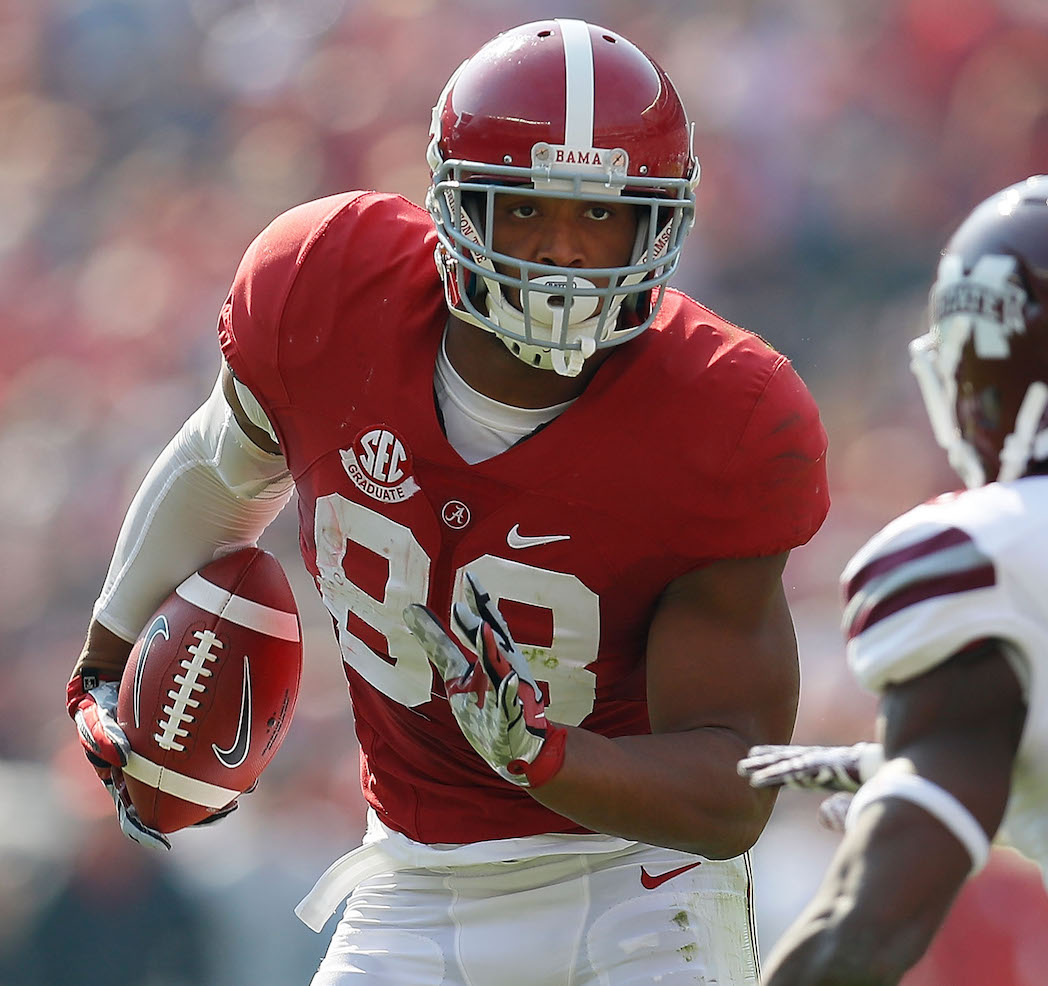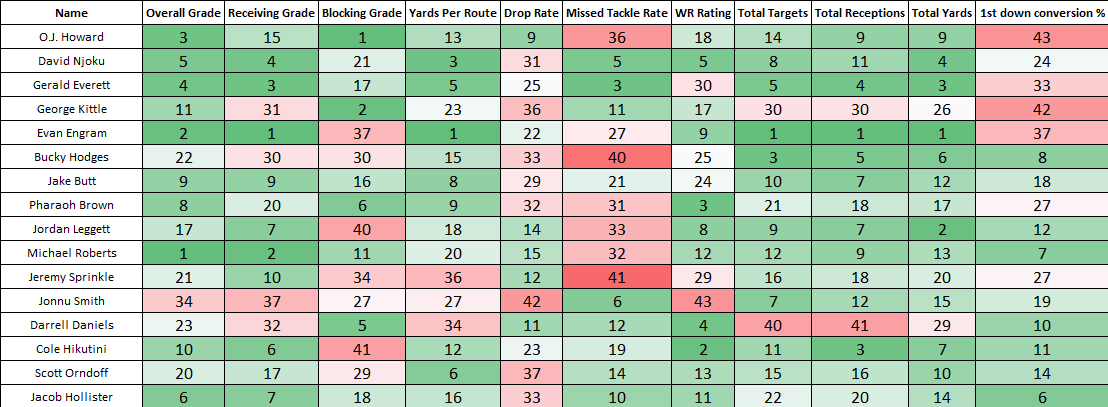[Editor’s note: This article was originally published on March 23, 2017, and updated on April 26 to reflect PFF’s final draft board.]
This tight end class has widely been considered the best group of sort-of-offensive-linemen-sort-of-receivers in quite some time, and rightfully so. Not only is this class stacked with some premier talent at the top of it, but it’s deep, littered with a slew of guys who should be able to contribute on Sundays for years to come, even if they aren’t getting the hype that the top of the class has received thus far. If you’re favorite team needs to improve at tight end, there’s potential for striking gold in this years NFL draft.
[Editor’s note: A player’s ranking within the draft class for each particular category is noted in the corresponding box.]
Rankings
Howard owns a unique blend of size and athleticism that is simply coveted in today’s NFL at the tight end position. Howard was PFF’s top-graded run-blocking college tight end this past season, and it’s tough to find any major red flags in his game. He’s an athletic mismatch, capable of taking advantage of smaller defensive backs while having the speed and quickness to consistently separate from linebackers; he has sure hands, as he’s recorded just six total drops over the last three seasons. Howard has also graded positively as a run-blocker in each of the last three seasons, including 2016 when he earned the highest run-blocking grade among tight ends.
O.J. Howard earned the number one overall grade among tight ends, including the top run-blocking grade in 2016.https://t.co/3fAFpUyEMB
— PFF (@PFF) March 2, 2017
If you’ve ever wished that your favorite team had Jordan Reed on it, now is your chance to get him, because Njoku is his clone. Njoku isn’t overly elusive, but he’s extremely effective with the ball in his hands due to a combination of his size, top-end speed and a willingness to just punch a defense in the mouth. He averaged 11.2 yards after the catch in 2016, the most by all draft-eligible tight ends by over a yard. There are concerns with Njoku’s ability as a run-blocker — he graded out in the middle of the pack, and can get too tall while moving laterally — but his receiving ability makes him a Day 1 starter and someone you want to feed the ball too often.
"Don’t be surprised if there’s a highlight of David Njoku hurdling over a defender next season."
Scouting report:https://t.co/qr1tXDJPpZ
— PFF College (@PFF_College) March 7, 2017
3. Gerald Everett, TE, South Alabama
Everett is an athletic freak, earning “top performer” marks at the NFL Combine in the following events: bench press (22 reps, third-most among TEs), vertical jump (37.5 inches, third-best), broad jump (126 inches, fifth-best), 3-cone drill (6.99 seconds, fourth-best) and the 20-yard shuttle (4.33 seconds). That athleticism stands out on his tape, as well. He’s a nightmare to bring down with the ball in his hands — Everett forced 24 missed tackles in 2016, nine more than any other tight end — and his short-term burst, paired with his size and agility, make it quite difficult for linebackers to match up with him one-on-one. He shows no fear of contact when running routes over the middle and his balance is one of his greatest strengths. Everett showed multiple times on film that he’s capable of absorbing a blow before continuing on downfield. He’s raw — a classic case of “played basketball in high school and got into football late” — and his technique as both a route-runner and run-blocker need work, but if he’s able to clean that up with NFL coaching, he could be a Pro Bowl-level tight end.
Engram is arguably the best tight end in this class out of the slot, and he’s a legitimate deep threat. Over the past two seasons on balls thrown at least 20 yards in the air, Engram has hauled in 10 of 17 attempts for 337 yards and three touchdowns. He’s quite athletic with great short-term burst; he moves fluidly and tracks the ball well downfield and is capable of winning hand fights to create late separation. Engram doesn’t offer much as a run-blocker — his grading regressed from 2015 to 2016, and at times it looks like he just ducks his head and goes in blind when throwing a block — but there may not be a better tight end in this class at stretching the middle of the field.
Our scouting report on Ole Miss TE Evan Engram says he needs to work on his blocking. https://t.co/4g7mf0yEfO
— PFF College (@PFF_College) March 12, 2017
While Kittle may not possess the size to become a reliable, in-line blocker, his sound technique, willingness to block and above-average athleticism make him a great No. 2 tight end in a “move” role. He’s one of the best in the class at blocking on the move, where he can use his athleticism and instincts to take advantage of angles and leverage. Kittle possesses the quickness and speed that should make him a versatile receiving threat capable of running routes from multiple positions, as well. At the very least, he’ll be a reliable underneath threat capable of gaining yards after the catch and moving the chains.
"You can spend a 1st on OJ Howard, or you can take George Kittle in the 3rd and get an elite player in round 1 instead."@PFF_Josh pic.twitter.com/L1J6uFa66Y
— PFF College (@PFF_College) March 9, 2017
6. Bucky Hodges, TE, Virginia Tech
Standing at 6-foot-6 with out-of-the-stadium leaping ability, Hodges should step in and become a red-zone weapon for an NFL offense. He has minimal experience lining up with his hand in the dirt, and doesn’t offer a whole lot as a run blocker or pass protector, but he’s capable of lining up both in the slot and out wide, and he’s productive at all three levels. Hodges’ limited ability as a blocker, paired with his limited ability to create yards after the catch — he averaged just 3.0 yards after the catch last season — will likely cap his role within an NFL offense, but in terms of being a big-bodied target, he has a lot to offer.
Expecting Butt to be the complete package as an NFL tight end is probably asking too much. He has blatant limitations as a run-blocker, both at the line of scrimmage and as he moves up the field. Butt isn’t overly athletic, but he doesn’t mess around with the ball in his hands; he turns up field as soon as he’s secured the catch and looks to squeeze out as many yards as he can. Big plays are going to be few and far between for Butt in the NFL, and he isn’t going to have much success creating separation when manned up in coverage, but his penchant for finding the holes in zone coverages — especially in the short-to-intermediate range — and getting upfield will help an offense move the chains.
8. Jacob Hollister, TE, Wyoming
Hollister showed continued improvement in college, putting together a strong 2016 that showed off his playmaking ability. He’s a nifty route-runner who can go up and make plays in traffic, and he did a fine job after the catch, averaging 7.1 YAC in 2016.
9. Jeremy Sprinkle, TE, Arkansas
It’s a deep tight end class, and Sprinkle is another big-bodied option who can create mismatches in the passing game. He doesn’t have to be open to create a big play, and he can be a valuable asset while lining up all over the formation. He has work to do to improve in the run game, but Sprinkle has the size and route-running to make an impact in the pass game.
10. Adam Shaheen, TE, Ashland
Adam Shaheen is a big and athletic tight end prospect, and teams will be intrigued by what he can contribute as a pass catcher. The big concern is that Shaheen’s level of competition was considerably lower than the other prospects in the class.
Class superlatives
Best hands: O.J. Howard, Alabama
Not only has Howard dropped just six balls over the past three seasons combined, his catch radius is quite impressive. Howard is able to go down low and peel balls off the grass on one play and then grab a ball off of his back shoulder the next.
Best route runner: O.J. Howard, Alabama
Howard’s athleticism shines when it comes to running his routes. He’s such a gifted athlete, with exceptional acceleration and agility that he uses to create separation virtually at will.
Best after the catch: Gerald Everett, South Alabama
Everett is a nightmare to bring down in the open field. He’s athletically gifted, and his explosiveness and balance are two of his greatest attributes. Everett is quick enough to make people miss, but he’s also able to absorb contact while maintaining his momentum. He’s strong enough to drag defenders for extra yardage if they don’t hit him with force. David Njoku deserves an honorable mention here, but Everett takes it in a close one.
Best run blocker: George Kittle, Iowa
Kittle’s ability as a run-blocker shines when you throw on his game tape. He’s excellent at blocking on the move while demonstrating excellent footwork, balance and leverage. While he may lack the size to develop into a consistent in-line blocker, he’s a weapon when asked to block from off the line, which is a big reason why he finished the year with the second-highest run-blocking grade among draft eligible tight ends.
For more positional prospect rankings and statistics, access PFF Draft Pass today.
Position ranks: QB | RB | WR | TE | OT | OG | C | EDGE | DT | LB | CB | S




 © 2025 PFF - all rights reserved.
© 2025 PFF - all rights reserved.